Government Official Knowledge About 4K Concept Improving Family Resilience in Bandung
DOI:
https://doi.org/10.18502/kss.v8i18.14323Abstract
This study aims to describe how the knowledge of government officials of Bandung City, about the 4K concept (family gathering, family interacting, family caring, and family empowerment) can increase family resilience in the city of Bandung. This study uses qualitative research methods, with a social construction of reality approach. The research was conducted in 2 sub-districts that have a very low level of family resilience, namely Cibeunying Kidul District and Kiaracondong District. Data collection was carried out by in-depth interviews with the government officials and community in the selected sub-districts. The results of the study can be concluded as follows: (1) The family resilience in Cibeunying Kidul Subdistrict, represented by Pasir Layung, Sukapada, and Cicadas Villages, and Kiaracondong Subdistrict, represented by Cicaheum, Sukapura, and Kebon Jayanti Villages is still relatively low, meaning that the ability of residents to build independent, prosperous, and harmonious families has not been achieved. Of the 5 dimensions of family resilience, the most prominent problems were in the aspect of communication disharmony and domestic violence, child marriage, malnutrition, stunting, and divorce. (2) The government officials knowledge in Cibeunying Kidul District and Kiaracondong District about the 4K concept in communication family is an effort to increase family resilience only at the level of knowing and understanding. Meanwhile, at the stage of analyzing the aspects contained in the 4K concept (family gathering, family interacting, family empowering, and family sharing) it is still not optimal.
Keywords: family communication, 4K concept, family resilience, cognition
References
[2] Galvin KGKM, Brommel B. “Family communication: Cohesion and change,” 1991.
[3] Rakhmat J. “Psikologi Komunikasi. Remaja Rosdakarya. Bandung. Siagian, Administrasi Pembangunan, Jakarta: Gunung Agung, 1993, hlm. 5,” 2008.
[4] Djamarah SB. Pola Komunikasi Orang Tua Dan Anak Dalam Keluarga; Sebuah Perspektif Pendidikan Islam. Jakarta: Rineka Cipta; 2004.
[5] Gunarsa S. Psikologi Perkembangan Anak dan Dewasa. Jakarta: Gunung. Mulia. Hurlock.J.B; 2006.
[6] Ii BAB, Keluarga AK, Keluarga PK. “No title.” no. 1989, 2008.
[7] “No Title,” 2019.
[8] Friedman MM. Buku ajar keperawatan keluarga: riset teori dan praktek. Jakarta: EGC; 2010.
[9] Mursafitri E. “Hubungan Fungsi Afektif Keluarga Dengan Kenakalan Remaja,” PSIK UMSB.
[10] Manik. “Gambaran Fungsi Afektif Keluarga dan Perilaku Seksual Remaja,” Keperawatan Indones., 2009.
[11] Wirawan S. Pengantar Psikologi. Jakarta: Grafindo Persada; 2013.
[12] Elisa AT, S, Wrastari. “Sikap Guru Terhadap Pendidikan Inklusi Ditinjau Dari Faktor Pembentuk Sikap. Jurnal Psikologi Perkembangan Dan Pendidikan. 2013;2(01):1–10.
[13] Susantyo B. “MEMAHAMI PERILAKU AGRESIF : Sebuah Tinjauan Konseptual,” vol. 16, no. 03, pp. 189–202. https://doi.org/10.33007/inf.v16i3.48.
[14] Creswell, Research Design: Qualitative and Quantitati. 2012.
[15] Title H, et al. Table of Contents.

